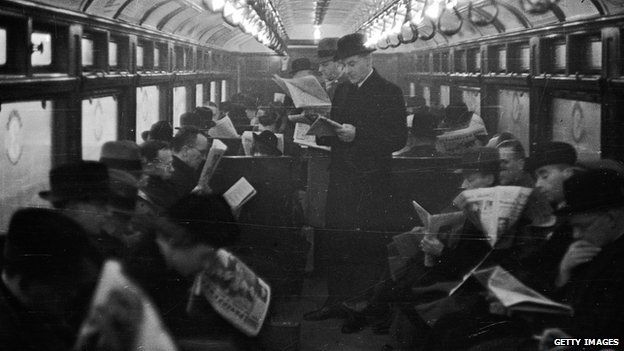What can the 1930s tell us about public spending?
- Published

One of Labour's most potent lines of attack is that the government's fiscal plans are so tight they will see spending on departments cut back to 1930s levels. But does a comparison with eight decades ago really tell us anything interesting about public spending?
The line does not originate with Labour but with the Office for Budget Responsibility (OBR), the independent body established in 2010 that carries out economic and financial forecasts for the Treasury.
According to the OBR, the spending plans outlined at last year's Autumn Statement would see "government consumption of goods and services" fall to its lowest level, as a share of national income, since 1938.
This is not a straightforward measure of government spending, but it is one that can be traced back before World War Two.
Put simply, it is government spending on departments, not total government spending. It excludes capital projects, the debt interest bill, and the social security system, welfare and pensions. This is the measure that is forecast to fall, as a share of the economy, back to 1938 levels.
The chart shows government spending has increased considerably in real terms since 1950, until 2009 when it began to drop. Spending is measured on an index, with inflation and other changes stripped out.
Of course in real terms (adjusting for inflation) the actual level of government spending will be much higher than in 1938 - the economy is simply many times bigger.
The 1930s are potentially politically toxic. The popular memory is one of mass unemployment, hunger marches and misery. In reality the worst of Britain's depression actually occurred in the 1920s and the early 1930s, by the end of the decade the economy was growing strongly.
Crucially, public spending in the late 1930s looked very different to that in the early part of the decade. By 1938, Britain had embarked on a rearmament programme ahead of the War.
This drove up defence spending and, as a share of national income, it was two and half times as high in the late 1930s as it is projected to be by the late 2010s. Running a global empire and the world's largest navy were not exactly cheap.
The big shift in public spending has been lower defence costs and more spending on health.
Strip out defence spending and, even as a share of national income, spending on government departments by the end of the next Parliament is forecast to be higher than in the 1930s. And as this analysis just looks at government services - it excludes the bulk of the welfare state that grew up after 1945.
Drastic change
Another thing to note is that, because of the oddities of coalition and the lack of a spending review post-2016, the spending plans outlined in the Autumn Statement, from which the 1930s comparisons are drawn, are not actually the spending plans on which either the Conservatives or the Liberal Democrats are planning to fight the next election.
Both parties have their own fiscal plans, which imply fewer cuts to departmental spending.
There are many problems with the claim that public spending could be heading back to 1930s levels:
- It excludes much government spending
- It will still be many times higher in real terms
- The late 1930s were distorted by defence spending
- No party is actually fighting the election on these plans
But none of that means the OBR's observation was not helpful.
The plans outlined in the Autumn Statement do imply a drastic change in the size and shape of the British state.
As Gemma Tetlow, of the Institute of Fiscal Studies, has said: "The government's current plans suggest that total spending as a share of national income will fall back to about 35% of national income by 2019.
"That's slightly lower than we've seen in any other year since the end of WW2.
"But perhaps more importantly, the composition of that spending is going to be quite different by 2019."
That is a very big change, and because we will be spending more on things like debt interest and pensions while protecting NHS spending, the squeeze on other departments would be very tough indeed.
Even if talk of the 1930s is less useful than it appears, it does bring home the reality of how big a squeeze is being planned for the next Parliament.
Watch Duncan's film on Newsnight on BBC Two on 12 February at 22.35.